Farm-Scale Biofuel Crop Adoption and Its Effects on In-Basin Water Balance
Abstract
1. Introduction
2. Materials and Methods
2.1. Study Watershed
2.2. SWAT Model Description
2.3. Input Data
2.4. SWAT Sensitivity Analysis, Calibration, Validation, and Performance Evaluation
2.5. Scenario Analysis
3. Results
3.1. SWAT Model Sensitivity Analysis
3.2. SWAT Model Calibration and Validation
3.3. Crop Change Effects on Water Balance Parameters
4. Discussion
4.1. Hydrological Modeling with SWAT
4.2. Water Balance Response to Crop Changes
4.3. Implications for Crop Management in the Czech Republic
5. Conclusions
Author Contributions
Funding
Conflicts of Interest
References
- David, J.S.; Henriques, M.O.; David, T.S.; Tomé, J.; Ledger, D.C. Clearcutting effects on streamflow in coppiced Eucalyptus globulus stands in Portugal. J. Hydrol. 1994, 162, 143–154. [Google Scholar] [CrossRef]
- Stednick, J.D. Monitoring the effects of timber harvest on annual water yield. J. Hydrol. 1996, 176, 79–95. [Google Scholar] [CrossRef]
- Neary, D.G.; Gottfried, G.J.; Folliott, P.F. Post-Wildfire Watershed Flood Responses. In Proceedings of the 2nd International Wildland Fire Ecology and Fire Management Congress, Orlando, FL, USA, 16–20 November 2003. [Google Scholar]
- Bruijnzeel, L.A. Hydrological functions of tropical forests: Not seeing the soil for the trees? Agric. Ecosyst. Environ. 2004, 104, 185–228. [Google Scholar] [CrossRef]
- Beck, H.E.; Bruijnzeel, L.A.; van Dijk, A.I.J.M.; McVicar, T.R.; Scatena, F.N.; Schellekens, J. The impact of forest regeneration on streamflow in 12 mesoscale humid tropical catchments. Hydrol. Earth Syst. Sci. 2013, 17, 2613–2635. [Google Scholar] [CrossRef]
- Wu, W.; Hall, C.A.S.; Scatena, F.N. Modelling the impact of recent land-cover changes on the stream flows in northeastern Puerto Rico. Hydrol. Process. 2007, 21, 2944–2956. [Google Scholar] [CrossRef]
- Bi, H.; Liu, B.; Wu, J.; Yun, L.; Chen, Z.; Cui, Z. Effects of precipitation and landuse on runoff during the past 50 years in a typical watershed in Loess Plateau, China. Int. J. Sediment Res. 2009, 24, 352–364. [Google Scholar] [CrossRef]
- Webb, A.A.; Kathuria, A. Response of streamflow to afforestation and thinning at Red Hill, Murray Darling Basin, Australia. J. Hydrol. 2012, 412–413, 133–140. [Google Scholar] [CrossRef]
- Zhang, M.; Liu, N.; Harper, R.; Li, Q.; Liu, K.; Wei, X.; Ning, D.; Hou, Y.; Liu, S. A global review on hydrological responses to forest change across multiple spatial scales: Importance of scale, climate, forest type and hydrological regime. J. Hydrol. 2017, 546, 44–59. [Google Scholar] [CrossRef]
- Bauer, A.; Black, A.L. Soil Carbon, Nitrogen, and Bulk Density Comparisons in Two Cropland Tillage Systems after 25 Years and in Virgin Grassland. Soil Sci. Soc. Am. J. 1981, 45, 1166–1170. [Google Scholar] [CrossRef]
- Franzluebbers, A.J.; Stuedemann, J.A.; Schomberg, H.H.; Wilkinson, S.R. Soil organic C and N pools under long-term pasture management in the Southern Piedmont USA. Soil Biol. Biochem. 2000, 32, 469–478. [Google Scholar] [CrossRef]
- Bewket, W.; Stroosnijder, L. Effects of agroecological land use succession on soil properties in Chemoga watershed, Blue Nile basin, Ethiopia. Geoderma 2003, 111, 85–98. [Google Scholar] [CrossRef]
- Breuer, L.; Huisman, J.A.; Keller, T.; Frede, H.-G. Impact of a conversion from cropland to grassland on C and N storage and related soil properties: Analysis of a 60-year chronosequence. Geoderma 2006, 133, 6–18. [Google Scholar] [CrossRef]
- Bronson, K.F.; Zobeck, T.M.; Chua, T.T.; Acosta-Martinez, V.; van Pelt, R.S.; Booker, J.D. Carbon and Nitrogen Pools of Southern High Plains Cropland and Grassland Soils. Soil Sci. Soc. Am. J. 2004, 68, 1695–1704. [Google Scholar] [CrossRef]
- European Commission. Directive 2003/30/EC of the European Parliament and of the Council of 8 May 2003. On the Promotion of the Use of Biofuels or other Renewable Fuels for Transport; European Communities: Luxembourg, 2003. [Google Scholar]
- European Commission. Biofuels in the European Union. A Vision for 2030 and Beyond; European Communities: Luxembourg, 2006; ISBN 92-79-01748-9. [Google Scholar]
- European Commission. Directive 2009/30/EC of the European Parliament and of the Council of 23 April 2009. Amending Directive 98/70/EC as Regards the Specification of Petrol, Diesel and Gas-Oil and Introducing a Mechanism to Monitor and Reduce Greenhouse Gas Emissions and Amending Council Directive 1999/32/EC as Regards the Specification of Fuel Used by Inland Waterway Vessels and Repealing Directive 93/12/EEC; European Communities: Luxembourg, 2009. [Google Scholar]
- European Commission. Directive 2009/28/EC of the European Parliament and of the Council of 23 April 2009. On the Promotion of the Use of Energy from Renewable Sources and Amending and Subsequently Repealing Directives 2001/77/EC and 2003/30/EC; European Communities: Luxembourg, 2009. [Google Scholar]
- Kiniry, J.R.; Williams, J.R.; Major, D.J.; Izaurralde, R.C.; Gassman, P.W.; Morrison, M.; Bergentine, R.; Zentner, R.P. EPIC model parameters for cereal, oilseed, and forage crops in the northern Great Plains region. Can. J. Plant Sci. 1995, 75, 679–688. [Google Scholar] [CrossRef]
- Siddique, K.H.M.; Regan, K.L.; Tennant, D.; Thomson, B.D. Water use and water use efficiency of cool season grain legumes in low rainfall Mediterranean-type environments. Eur. J. Agron. 2001, 15, 267–280. [Google Scholar] [CrossRef]
- Kar, G.; Kumar, A.; Martha, M. Water use efficiency and crop coefficients of dry season oilseed crops. Agric. Water Manag. 2007, 87, 73–82. [Google Scholar] [CrossRef]
- Siebert, S.; Döll, P. Quantifying blue and green virtual water contents in global crop production as well as potential production losses without irrigation. J. Hydrol. 2010, 384, 198–217. [Google Scholar] [CrossRef]
- Gerbens-Leenes, W.; Hoekstra, A.Y.; van der Meer, T.H. The water footprint of bioenergy. Proc. Natl. Acad. Sci. USA 2009, 106, 10219–10223. [Google Scholar] [CrossRef]
- Kovats, R.S.; Valentini, R.; Bouwer, L.M.; Georgopoulou, E.; Jacob, D.; Martin, E.; Rounsevell, M.; Soussana, J.F. Climate Change 2014: Impacts, Adaptation and Vulnerability. Part B: Regional Aspects; Barros, V.R., Field, C.B., Dokken, D.J., Mastrandrea, M.D., Mach, K.J., Bilir, T.E., Chatterjee, M., Ebi, K.L., Estrada, Y.O., Genova, R.C., et al., Eds.; Cambridge University Press: Cambridge, UK; New York, NY, USA, 2014. [Google Scholar]
- Zelenakova, M.; Fialová, J.; Negm, A.M. Assessment and Protection of Water Resources in the Czech Republic; Springer: Berlin/Heidelberg, Germany, 2020. [Google Scholar] [CrossRef]
- Flach, B.; Lieberz, S.; Bolla, S. Biofuels Annual Report; Global Agricultural Information Network (GAIN) Report NL9022; United States Department of Agriculture (USDA) Foreign Agricultural Service: Washington, DC, USA, 2019.
- Ministry of Agriculture of the Czech Republic. We Support Traditions and Rural Development in the Czech Republic; Ministry of Agriculture of the Czech Republic: Prague, Czech Republic, 2018; ISBN 978-80-7434-416-9.
- Nordborg, M.; Cederberg, C.; Berndes, G. Modeling potential freshwater ecotoxicity impacts due to pesticide use in biofuel feedstock production: The cases of maize, rapeseed, salix, soybean, sugar cane, and wheat. Environ. Sci. Technol. 2014, 48, 11379–11388. [Google Scholar] [CrossRef]
- van Zelm, R.; van der Velde, M.; Balkovic, J.; Čengić, M.; Elshout, P.M.F.; Koellner, T.; Núñez, M.; Obersteiner, M.; Schmid, E.; Huijbregts, M.A.J. Spatially explicit life cycle impact assessment for soil erosion from global crop production. Ecosyst. Serv. 2018, 30, 220–227. [Google Scholar] [CrossRef]
- Mistr, M. Determination of Crop and Management Factor Values to Intensify Soil Erosion Control in the Czech Republic; QJ1530181; VUMOP v.v.i.: Prague, Czech Republic, 2019. (In Czech) [Google Scholar]
- Cwalina-Ambroziak, B.; Stępień, A.; Kurowski, T.P.; Głosek-Sobieraj, M.; Wiktorski, A. The health status and yield of winter rapeseed (Brassica napus L.) grown in monoculture and in crop rotation under different agricultural production systems. Arch. Agron. Soil Sci. 2016, 62, 1722–1732. [Google Scholar] [CrossRef]
- Arnold, J.G.; Srinivasan, R.; Muttiah, R.S.; Williams, J.R. Large Area Hydrologic Modeling and Assessment Part I: Model Development. J. Am. Water Resour. Assoc. 1998, 34, 73–89. [Google Scholar] [CrossRef]
- Neitsch, S.L.; Arnold, J.G.; Kiniry, J.R.; Williams, J.R. Soil and Water Assessment Tool Theoretical Documentation; Texas Water Resources Institute: College Station, TX, USA, 2011. [Google Scholar]
- Gassman, P.W.; Reyes, M.R.; Green, C.H.; Arnold, J.G. The Soil and Water Assessment Tool: Historical Development, Applications, and Future Research Directions. Trans. ASABE 2007, 50, 1211–1250. [Google Scholar] [CrossRef]
- Melaku, N.D.; Renschler, C.S.; Holzmann, H.; Strohmeier, S.; Bayu, W.; Zucca, C.; Ziadat, F.; Klik, A. Prediction of soil and water conservation structure impacts on runoff and erosion processes using SWAT model in the northern Ethiopian highlands. J. Soils Sediments 2018, 18, 1743–1755. [Google Scholar] [CrossRef]
- Du, B.; Ji, X.; Harmel, R.D.; Hauck, L.M. Evaluation of a Watershed Model for Estimating Daily Flow Using Limited Flow Measurements. JAWRA J. Am. Water Resour. Assoc. 2009, 45, 475–484. [Google Scholar] [CrossRef]
- Brzozowski, J.; Miatkowski, Z.; Śliwiński, D.; Smarzyńska, K.; Śmietanka, M. Application of SWAT model to small agricultural catchment in Poland. J. Water Land Dev. 2011, 15, 719. [Google Scholar] [CrossRef]
- Peraza-Castro, M.; Ruiz-Romera, E.; Meaurio, M.; Sauvage, S.; Sánchez-Pérez, J.M. Modelling the impact of climate and land cover change on hydrology and water quality in a forest watershed in the Basque Country (Northern Spain). Ecol. Eng. 2018, 122, 315–326. [Google Scholar] [CrossRef]
- Hanel, M.; Mrkvičková, M.; Máca, P.; Vizina, A.; Pech, P. Evaluation of Simple Statistical Downscaling Methods for Monthly Regional Climate Model Simulations with Respect to the Estimated Changes in Runoff in the Czech Republic. Water Resour. Manag. 2013, 27. [Google Scholar] [CrossRef]
- Zumr, D.; Dostál, T.; Devátý, J. Identification of prevailing storm runoff generation mechanisms in an intensively cultivated catchment. J. Hydrol. Hydromech. 2015, 63, 246–254. [Google Scholar] [CrossRef]
- Arnold, J.G.; Moriasi, D.N.; Gassman, P.W.; Abbaspour, K.C.; White, M.J.; Srinivasan, R.; Santhi, C.; Harmel, R.D.; van Griensven, A.; van Liew, M.W.; et al. SWAT: Model Use, Calibration, and Validation. Trans. ASABE 2012, 55, 1491–1508. [Google Scholar] [CrossRef]
- Moriasi, D.N.; Arnold, J.G.; van Liew, M.W.; Bingner, R.L.; Harmel, R.D.; Veith, T.L. Model Evaluation Guidelines for Systematic Quantification of Accuracy in Watershed Simulations. Trans. ASABE 2007, 50, 885–900. [Google Scholar] [CrossRef]
- Tuppad, P.; Douglas-Mankin, K.R.; Lee, T.; Srinivasan, R.; Arnold, J.G. Soil and Water Assessment Tool (SWAT) Hydrologic/Water Quality Model: Extended Capability and Wider Adoption. Trans. ASABE 2011, 54, 1677–1684. [Google Scholar] [CrossRef]
- Nyeko, M. Hydrologic Modelling of Data Scarce Basin with SWAT Model: Capabilities and Limitations. Water Resour. Manag. 2015, 29, 81–94. [Google Scholar] [CrossRef]
- Beven, K. How far can we go in distributed hydrological modelling? Hydrol. Earth Syst. Sci. Discuss. Eur. Geosci. Union 2001, 5, 1–12. [Google Scholar] [CrossRef]
- Martínez-Retureta, R.; Aguayo, M.; Stehr, A.; Sauvage, S.; Echeverría, C.; Sánchez-Pérez, J.-M. Effect of Land Use/Cover Change on the Hydrological Response of a Southern Center Basin of Chile. Water 2020, 12, 302. [Google Scholar] [CrossRef]
- Geza, M.; McCray, J.E. Effects of soil data resolution on SWAT model stream flow and water quality predictions. J. Environ. Manag. 2008, 88, 393–406. [Google Scholar] [CrossRef]
- Daggupati, P.; Douglas-Mankin, K.R.; Sheshukov, A.Y.; Barnes, P.L.; Devlin, D.L. Field-Level Targeting Using SWAT: Mapping Output from HRUs to Fields and Assessing Limitations of GIS Input Data. Trans. ASABE 2011, 54, 501–514. [Google Scholar] [CrossRef]
- Chaplot, V. Impact of spatial input data resolution on hydrological and erosion modeling: Recommendations from a global assessment. Phys. Chem. Earth Parts A/B/C 2014, 67–69, 23–35. [Google Scholar] [CrossRef]
- Qi, J.; Zhang, X.; Yang, Q.; Srinivasan, R.; Arnold, J.G.; Li, J.; Waldholf, S.T.; Cole, J. SWAT ungauged: Water quality modeling in the Upper Mississippi River Basin. J. Hydrol. 2020, 584, 124601. [Google Scholar] [CrossRef]
- Jodar-Abellan, A.; Valdes-Abellan, J.; Pla, C.; Gomariz-Castillo, F. Impact of land use changes on flash flood prediction using a sub-daily SWAT model in five Mediterranean ungauged watersheds (SE Spain). Sci. Total Environ. 2019, 657, 1578–1591. [Google Scholar] [CrossRef]
- Qi, J.; Li, S.; Bourque, C.P.-A.; Xing, Z.; Meng, F.-R. Developing a decision support tool for assessing land use change and BMPs in ungauged watersheds based on decision rules provided by SWAT simulation. Hydrol. Earth Syst. Sci. 2018, 22, 3789–3806. [Google Scholar] [CrossRef]
- Pitman, J.I. Rainfall interception by bracken in open habitats—Relations between leaf area, canopy storage and drainage rate. J. Hydrol. 1989, 105, 317–334. [Google Scholar] [CrossRef]
- Krasa, J.; Dostal, T.; Zumr, D.; Tejkl, A.; Bauer, M. Recent Trends in Crop Rotation in the Czech Republic and Associated Soil Erosion Risks. In Proceedings of the 22nd European Geological Union General Assembly, Vienna, Austria, 4–8 May 2020. [Google Scholar]
- Salsabilla, A.; Kusratmoko, E. Assessment of soil erosion risk in Komering watershed, South Sumatera, using SWAT model. AIP Conf. Proc. 2017, 1862. [Google Scholar] [CrossRef]
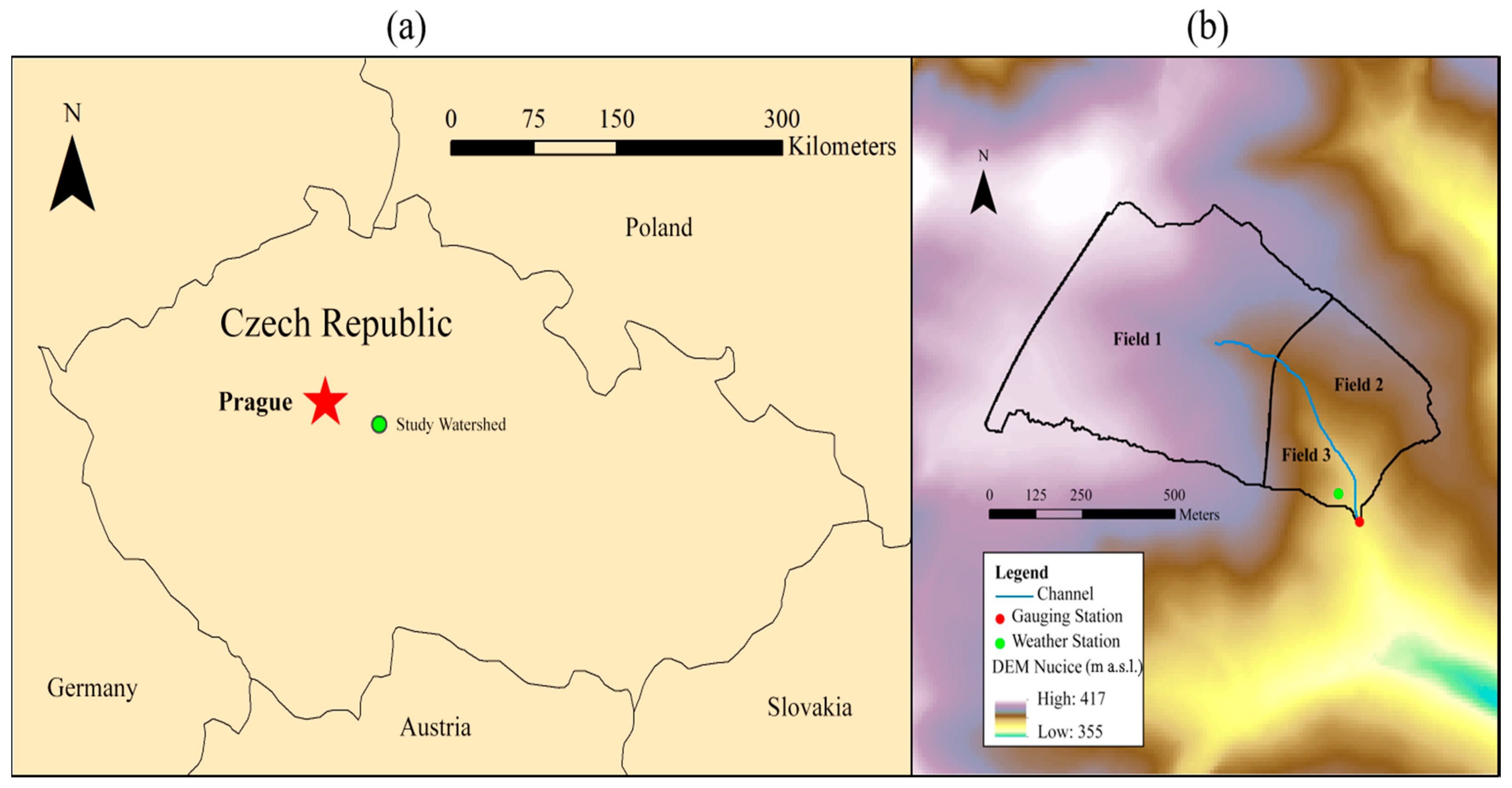
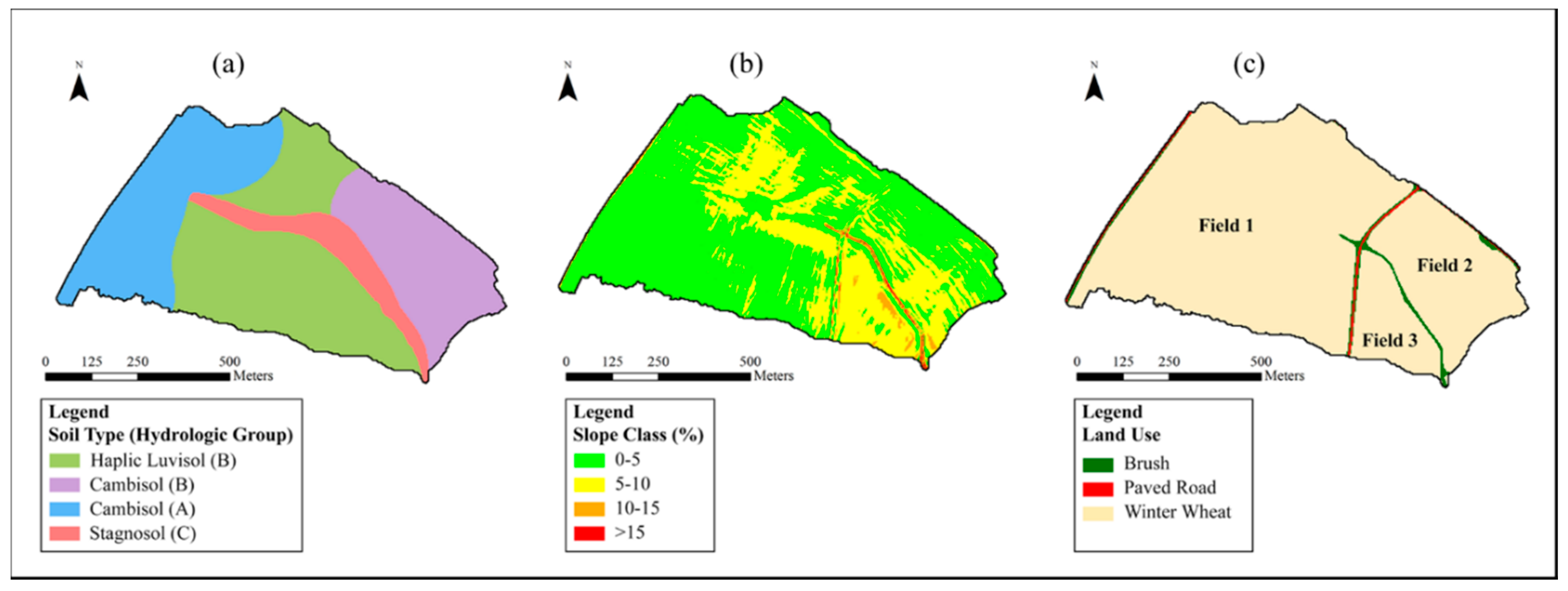
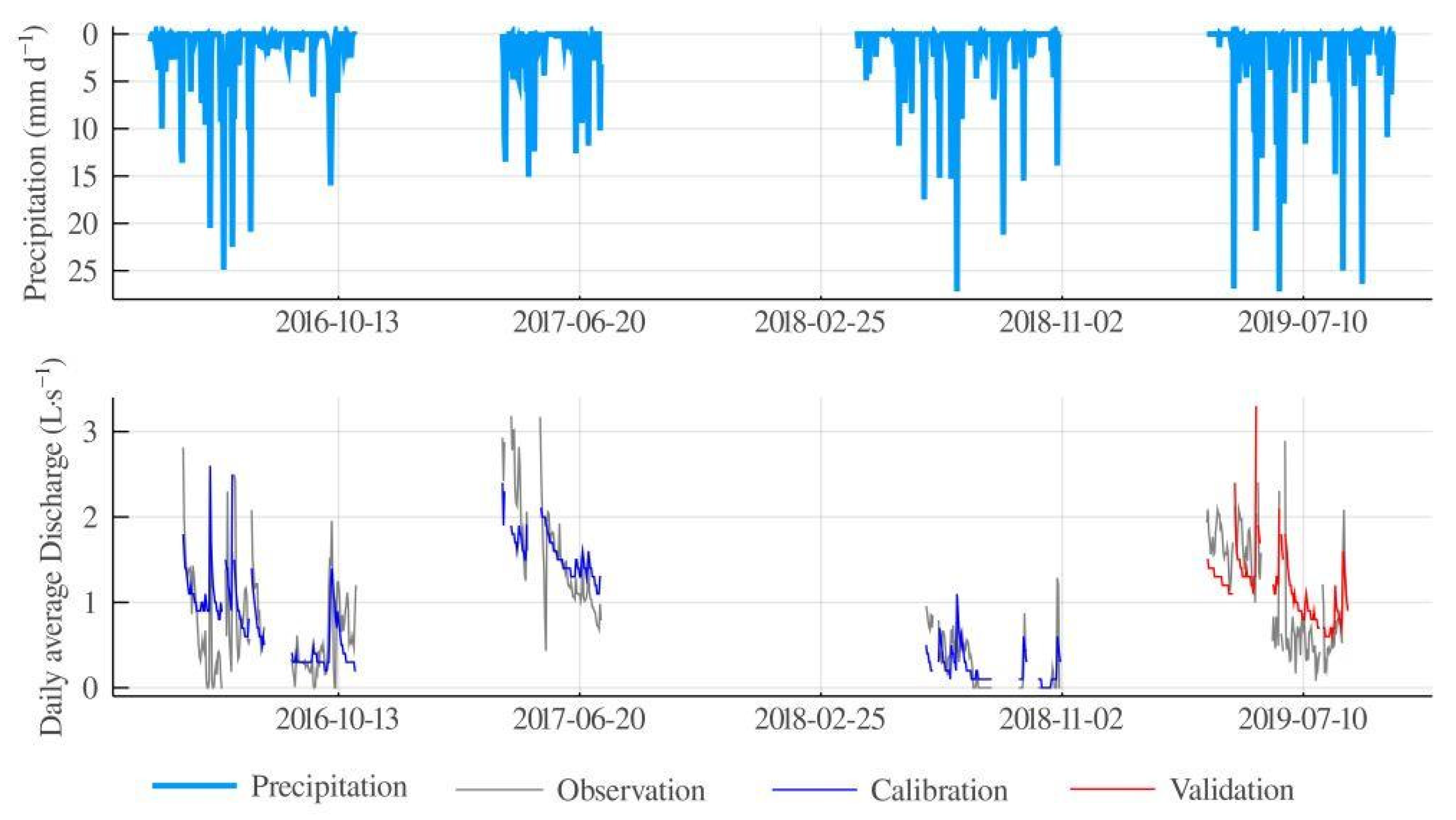
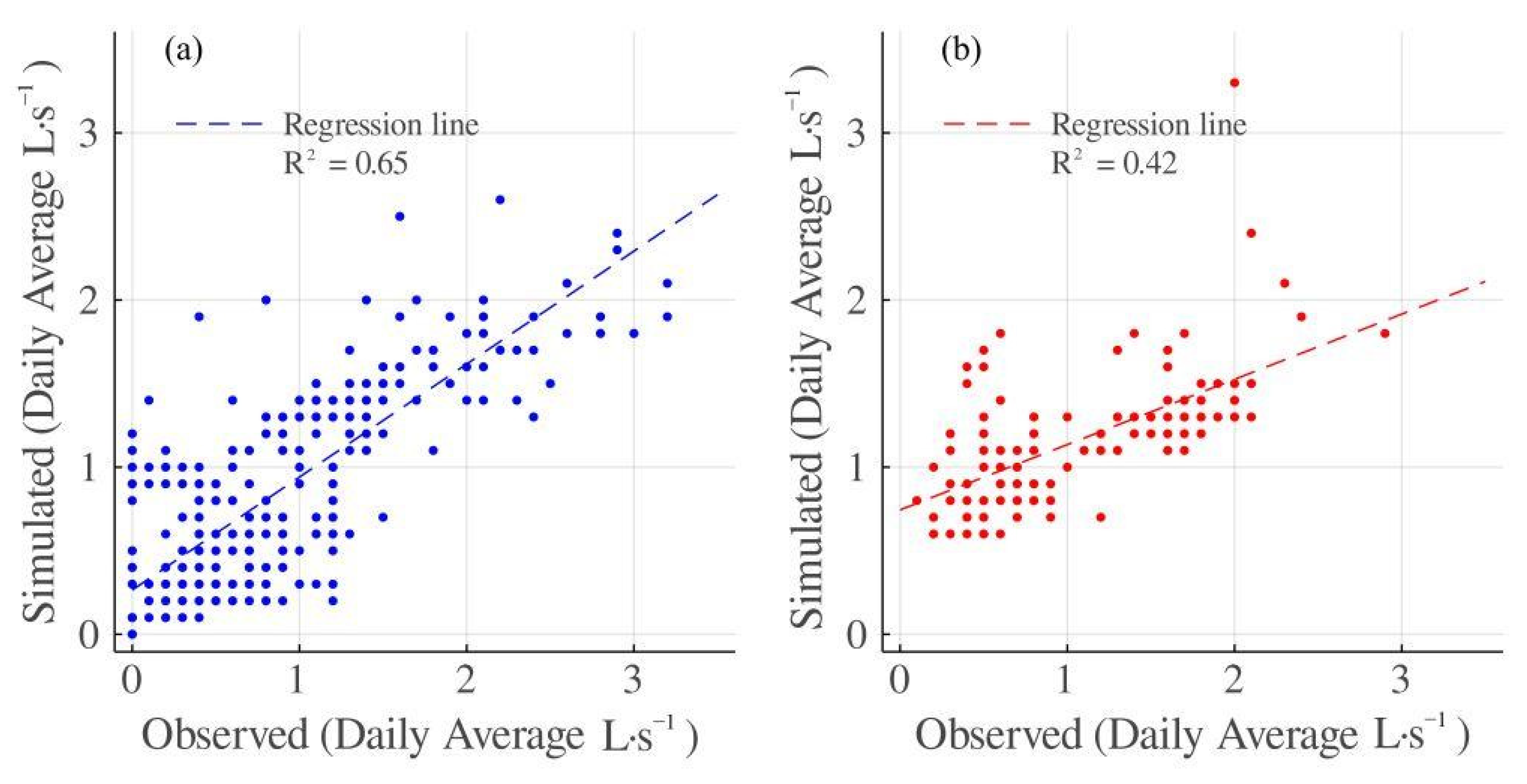
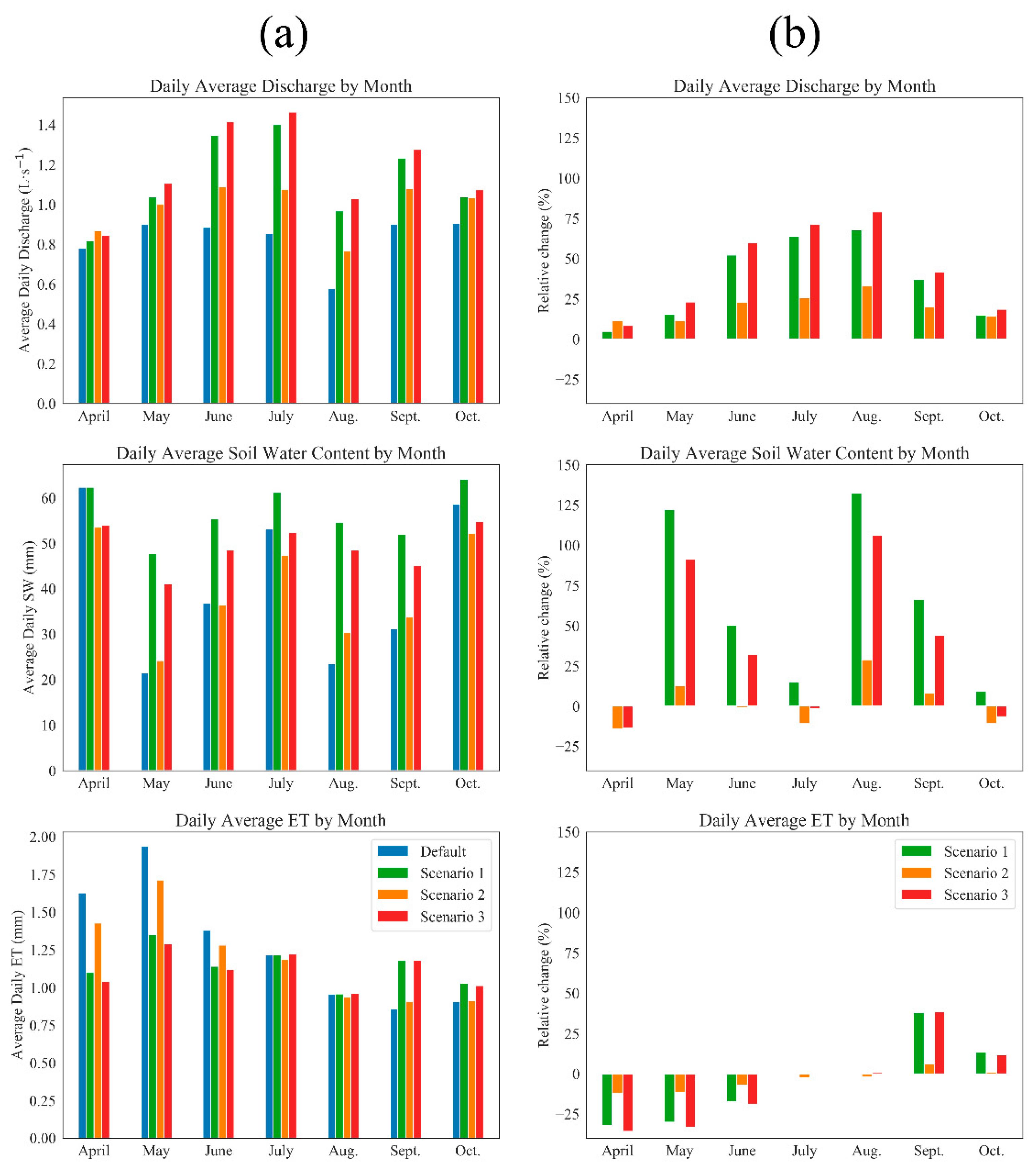
| Input Data | Description | Source | |
|---|---|---|---|
| Meteorological Data | Extreme Temperatures | Minimum and maximum daily temperatures (2011–2019) | On-site: 107 Temperature Probe (Campbell Sci., UK) |
| Precipitation | Total daily precipitation (2011–2019) | On-site: MR3-01s Tipping Bucket (Meteo Servis, Czech Republic) | |
| Spatial Data | DEM | Digital elevation model (3 m resolution) | LiDAR Survey: Czech Institute of Geodesy and Cartography |
| Soil Type | Soil map of the Czech Republic 1:5000 | State Land Office of the Czech Republic | |
| Land Use | Digitized from detailed orthophoto | UAV Survey: Czech Technical University |
| Parameter | Definition | File | Method | Min | Max |
|---|---|---|---|---|---|
| ESCO | Soil evaporation compensation factor | bsn | V | 0.5 | 0.95 |
| SURLAG | Surface runoff lag coefficient (days) | bsn | V | 0.001 | 15 |
| ALPHA_BF | Base flow recession constant (days) | gw | V | 0.001 | 1 |
| RCHRG_DP * | Deep aquifer percolation fraction | gw | V | 0.001 | 1 |
| GW_DELAY * | Delay time for aquifer recharge (days) | gw | A | −45 | 60 |
| GW_REVAP * | Groundwater revap coefficient | gw | V | 0.02 | 0.2 |
| GWQMN | Threshold water level in shallow aquifer for base flow (mm) | gw | A | −2000 | 2000 |
| OV_N | Manning’s n value for overland flow | hru | V | 0.05 | 0.8 |
| DEP_IMP * | Depth to impervious layer in soil profile (mm) | hru | A | −1500 | 4000 |
| SLSOIL | Slope length for lateral subsurface flow (m) | hru | R | −0.25 | 0.25 |
| CN2 | Initial SCS curve number for moisture condition II | mgt | R | −0.2 | 0.2 |
| DDRAIN_BSN | Depth to subsurface drain (mm) | mgt | A | −500 | 500 |
| TDRAIN_BSN | Time to drain soil to field capacity (hours) | mgt | A | −40 | 40 |
| GDRAIN_BSN | Drain tile lag time (hours) | mgt | A | −40 | 40 |
| CH_N2 | Manning’s n for main channel | rte | V | 0.02 | 0.14 |
| SOL_AWC * | Available water capacity | sol | R | −0.75 | 0.75 |
| SOL_K * | Saturated hydraulic conductivity (mm·h−1) | sol | R | −0.5 | 0.5 |
| CH_K1 | Effective hydraulic conductivity of channel (mm·h−1) | sub | V | 0.025 | 150 |
| Scenario ID | Farmer A | Farmer B | Percent Basin Change |
|---|---|---|---|
| Default | Winter Wheat | Winter Wheat | 0 |
| S1 | Rapeseed | Winter Wheat | 90 |
| S2 | Winter Wheat | Rapeseed | 6 |
| S3 | Rapeseed | Rapeseed | 96 |
| Parameter | Winter Wheat (WWHT) | Rapeseed (CANP) | ||
|---|---|---|---|---|
| Default | Adjusted | Default | Adjusted | |
| Max Rooting Depth (m) | 1.3 | 1.4 | 0.9 | 1.3 |
| Max LAI (m2·m−2) | 4.0 | 5.0 | 3.5 | 3.0 |
| Min USLE C-Factor | 0.03 | 0.05 | 0.20 | 0.10 |
| Parameter | Method | Calibration Values | ||
|---|---|---|---|---|
| Minimum Value | Adjusted Value | Maximum Value | ||
| Groundwater “revap” coefficient | V | 0.02 | 0.086 | 0.2 |
| Deep aquifer percolation fraction | V | 0.001 | 0.48 | 1 |
| Delay time for aquifer recharge (days) | A | −45 | −32.31 | 60 |
| Depth to impervious layer in soil profile (mm) | A | −1500 | 3036.7 | 4000 |
| Available water capacity (mm) | R | −75% | −59% | +75% |
| Saturated hydraulic conductivity (mm·h−1) | R | −50% | 25% | +50% |
| Model Performance Indicator | Calibration (2016–2018) | Validation (2019) |
|---|---|---|
| NSE | 0.65 | 0.40 |
| PBIAS | −0.3% | −6.7% |
| R2 | 0.65 | 0.42 |
| KGE | 0.75 | 0.47 |
| p-factor | 0.55 | 0.71 |
| r-factor | 0.22 | 0.12 |
| Parameter | Default | Scenario 1 | Scenario 2 | Scenario 3 | ||
|---|---|---|---|---|---|---|
| Modeled | Normal | Modeled | Normal | Modeled | ||
| ET (mm·d−1) | 1.27 | 1.14 ** | 1.41 ** | 1.20 ** | 1.13 ** | 1.12 ** |
| SW (mm) | 40.96 | 56.72 ** | 48.04 ** | 39.62 ** | 41.43 ** | 49.15 ** |
| FLOW (L·s−1) | 0.829 | 1.120 ** | 1.088 ** | 0.989 ** | 0.846 ** | 1.129 ** |
| Month | SURQ | LATQ | ||||
|---|---|---|---|---|---|---|
| S1 | S2 | S3 | S1 | S2 | S3 | |
| April | 2.83 | 1.34 | 2.42 | 1.03 | 1.01 | 1.03 |
| May | 1.43 | 1.02 | 1.51 | 1.00 | 1.00 | 0.99 |
| June | 4.15 | 1.89 | 4.04 | 1.09 | 1.03 | 1.10 |
| July | 1.93 | 1.12 | 1.84 | 1.00 | 1.00 | 0.99 |
| Aug | 1.14 | 1.05 | 1.07 | 1.02 | 1.01 | 1.01 |
| Sept | 1.14 | 1.04 | 1.07 | 1.01 | 1.01 | 1.01 |
| Oct | 0.12 | 0.84 | 0.01 | 1.02 | 1.01 | 1.01 |
Publisher’s Note: MDPI stays neutral with regard to jurisdictional claims in published maps and institutional affiliations. |
© 2020 by the authors. Licensee MDPI, Basel, Switzerland. This article is an open access article distributed under the terms and conditions of the Creative Commons Attribution (CC BY) license (http://creativecommons.org/licenses/by/4.0/).
Share and Cite
Noreika, N.; Li, T.; Zumr, D.; Krasa, J.; Dostal, T.; Srinivasan, R. Farm-Scale Biofuel Crop Adoption and Its Effects on In-Basin Water Balance. Sustainability 2020, 12, 10596. https://doi.org/10.3390/su122410596
Noreika N, Li T, Zumr D, Krasa J, Dostal T, Srinivasan R. Farm-Scale Biofuel Crop Adoption and Its Effects on In-Basin Water Balance. Sustainability. 2020; 12(24):10596. https://doi.org/10.3390/su122410596
Chicago/Turabian StyleNoreika, Nina, Tailin Li, David Zumr, Josef Krasa, Tomas Dostal, and Raghavan Srinivasan. 2020. "Farm-Scale Biofuel Crop Adoption and Its Effects on In-Basin Water Balance" Sustainability 12, no. 24: 10596. https://doi.org/10.3390/su122410596
APA StyleNoreika, N., Li, T., Zumr, D., Krasa, J., Dostal, T., & Srinivasan, R. (2020). Farm-Scale Biofuel Crop Adoption and Its Effects on In-Basin Water Balance. Sustainability, 12(24), 10596. https://doi.org/10.3390/su122410596









